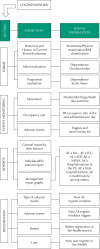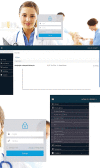Usability in the admission monitoring system of an emergency room
- PMID: 34932702
- PMCID: PMC8664066
- DOI: 10.11606/s1518-8787.2021055003475
Usability in the admission monitoring system of an emergency room
Abstract
Objective: To develop and evaluate the usability of the admission monitoring system in an emergency room.
Methods: This applied research intends to develop a software product and evaluate its usability. The development followed four stages: systematic review, structuring of the system framework, construction of system forms, and evaluation of the information generated. In the evaluation, the experts simulated the use of the system by inserting data from a fictitious medical record. We measured usability using the System Usability Scale (SUS). Scores and scores were calculated individually and globally. We propose these evaluation standards: worst case scenario, poor, average, good, excellent, and best-case scenario.
Results: The Sistema de Informação e Monitoramento das Internações em Pronto-Socorro (SIMIPS - Information and Monitoring System for Emergency Room Admissions) monitors the epidemiological profile of admissions to the emergency room, time management, clinical deterioration, incidence of adverse events, and human resource management. The usability of SIMIPS, evaluated by 17 experts, reached the SUS Score 86.5 (best case scenario), and some suggestions for modifications were accepted.
Conclusions: We consider SIMIPS an easy-to-use tool, with real importance in the management of emergencies in view of overcrowding and congestion problems faced in Brazil.
OBJETIVO: Desenvolver e avaliar a usabilidade de um sistema de monitoramento das internações em pronto-socorro.
MÉTODOS: Trata-se de uma pesquisa aplicada, com desenvolvimento de um produto de software e avaliação de sua usabilidade por enfermeiros especialistas. O desenvolvimento seguiu quatro etapas: revisão sistemática, estruturação do arcabouço do sistema, construção dos formulários do sistema e avaliação das informações geradas. Na avaliação, os especialistas simularam a utilização do sistema com a inserção de dados de um prontuário fictício, e a usabilidade foi medida pelo System Usability Scale (SUS). A pontuação e os escores foram calculados de forma individual e global. O sistema foi avaliado nos padrões: pior imaginável, pobre, mediano, bom, excelente e melhor imaginável.
RESULTADOS: O Sistema de Informação e Monitoramento das Internações em Pronto-Socorro (SIMIPS) realiza o monitoramento do perfil epidemiológico das internações no pronto-socorro, gestão de tempo, deterioração clínica, incidência de eventos adversos e gestão de recursos humanos. A usabilidade do SIMIPS, avaliada por 17 especialistas, atingiu o Score SUS 86,5 (melhor imaginável), e algumas sugestões de modificações foram acatadas.
CONCLUSÕES: O SIMIPS foi avaliado como uma ferramenta de fácil utilização, com real importância na gestão das urgências frente aos problemas de superlotação e congestão, enfrentados no Brasil.
Conflict of interest statement
Figures






References
MeSH terms
LinkOut - more resources
Full Text Sources

